Tech
Amazon’s Halo fitness tracker will measure your body fat… and tone of voice?
A wristband without a screen. A service that scans your body through your camera. An always-listening voice analysis that offers guidance on emotional tone. Amazon’s entry into the fitness space is odd indeed, and ambitious. And we’re just getting our minds wrapped around it.
Amazon has entered the health and fitness world with Halo, a subscription service and accompanying fitness band that unlocks an array of health metrics, including activity, sleep, body fat and tone of voice analysis, to determine your moods and your speech.
The band itself looks a lot like a screenless Fitbit tracker, but with a few different elements: It has temperature sensing, much like Fitbit’s newest smartwatch, the Fitbit Sense, and a microphone that continually scans a wearer’s voice to determine emotional tone. Yes, it’s a lot to take in. And the service is immediately available for early access. We haven’t even had a chance to try it out yet.

The membership part will start at $65 for the first six months ($100 once the early access deal is over) and then $3.99 a month after that. (International prices aren’t currently available, but $65 converts to about £50 or AU$90.) The subscription to Halo includes the basic fitness band that has one button, no screen and tracks your heart rate, steps and temperature. The lack of screen means you’ll have to rely on the mobile app to see all your data, but it does a lot more than just count your steps and log your weight.
An always-listening, emotionally analyzing Amazon health band that also lets you scan your body fat may sound like Black Mirror incarnate, but it’s also opening up some ideas in fitness that we’ve never seen before.
Body fat analysis with a smartphone camera
Amazon thinks the concept of weight loss is flawed, and that body fat is a much better predictor of health.
Most of us have been conditioned to obsess over our weight. The entire diet industry was built on it with programs, apps and devices that revolve around ways to lose pounds.
But weight can fluctuate daily based on factors including humidity, medication, menstrual cycle and illness. Plus muscle is more dense than fat, and a scale can’t tell the difference between the two. You could literally work your ass off building muscle and burning fat, and not see the numbers on the scale go down.
Rather than relying on weight, Halo focuses on body fat percentage, which is less volatile and takes a lot more time and work to change.
The gold standard in the medical world for body composition analysis is a DEXA scan (dual-energy absorptiometry), which can cost up to $100 at a lab. The Halo app does it all using your smartphone camera. Once you take your photos, the app automatically eliminates everything else in the background, calculates body fat percent based on body indicators, and then creates a 3D model of your body, which is both cool and terrifying. The app requires you to wear minimal form-fitting clothing and trust Amazon to take a picture of you wearing it. The entire process takes seconds.
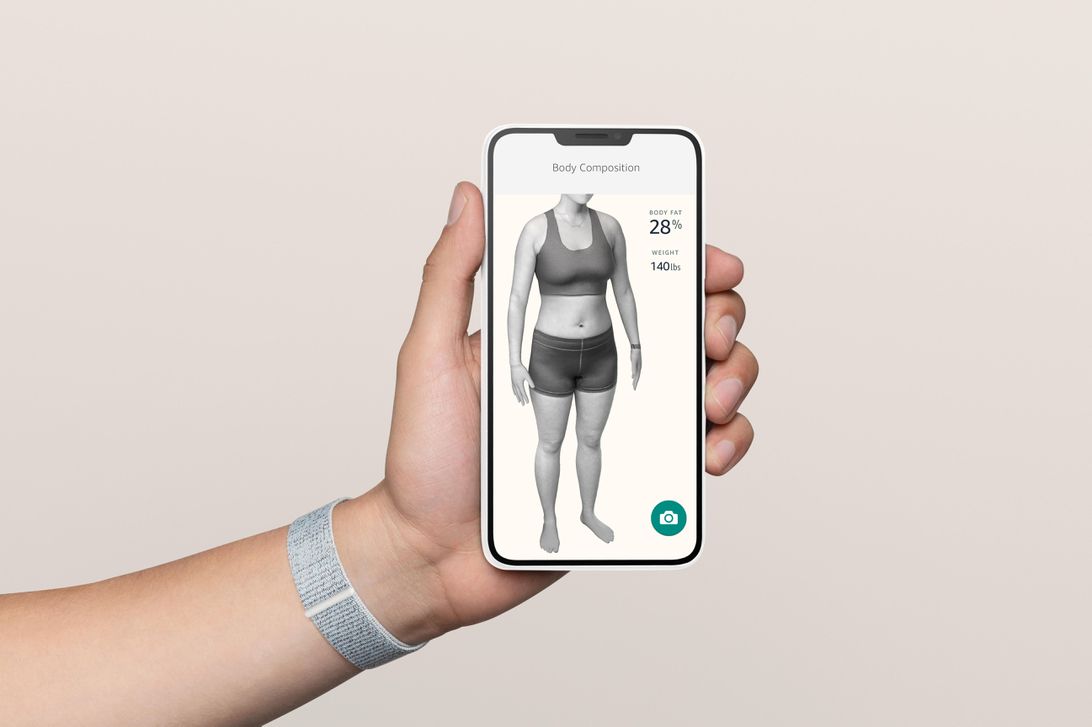
Amazon’s Halo app makes a 3D render of your body to analyze body fat, while the fitness band keeps tabs on sleep and activity.
Amazon
If you’re feeling uncomfortable, that’s not surprising: The idea of body-scanning with a camera is already an awkward proposition. Amazon doing this on a health platform makes it feel more so. The sample body-scan images Amazon showed me look very personal — not necessarily something I’d ever want anyone else to see.
That’s why Amazon promises that the finished body scans stay on your phone and won’t be shared with anybody, including the company, unless you opt into that. According to Amazon, “the images are processed in the cloud, but encrypted in transit and processed within seconds, after which they’re automatically deleted from Amazon’s systems and databases. All scan images are fully deleted within 12 hours. The scan images aren’t viewed by anyone at Amazon and aren’t used for machine learning optimizations.”
Watch that tone!
Halo also offers a Tone analysis, which has nothing to do with body tone, but rather analyzes the emotion of your voice. It also lets you know when you sound out of line, weirdly enough.
The fitness band has two built in mics to capture audio and is listening for emotional cues. The company says it’s not intended to analyze your conversation, but rather the tone of your voice. You can opt out of this by tapping the side button and will know when the mic is off when a red LED lights up on the band.
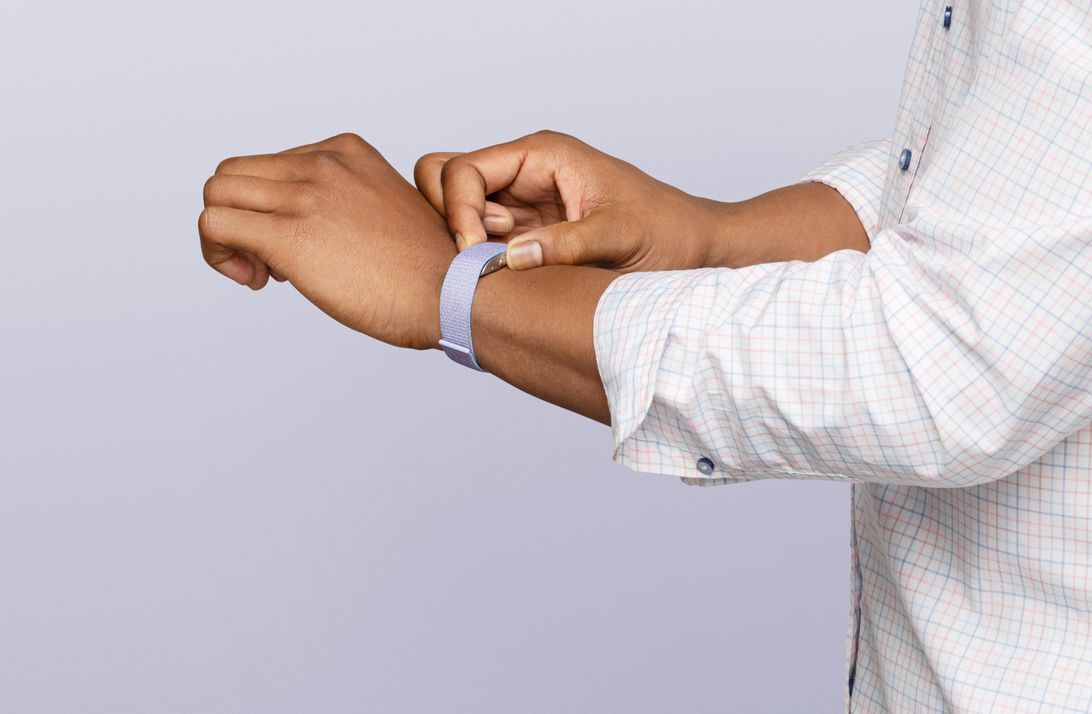
Otherwise, the voice scanning is happening continuously, pulling out the wearer’s voice specifically and delivering analysis with related emotional-tone words (like “happy,” or “concerned” in the Halo app). The idea, according to Amazon, is to help guide a wearer to deliver better tones of voice and speaking styles, almost a vocal form of posture. It isn’t intended as a form of psychological analysis, but it seems awfully hard to draw the line on a concept like this.
Amazon’s been exploring the idea of emotional tone-sensing since at least 2018, but this is the first time it’s approached the idea in any device. And according to Amazon, Tone is only happening on the Halo Band for now. Tone will be limited to the Halo band’s microphone, but Amazon sounds open to exploring the idea on other devices, depending on how the early access response goes from first-wave wearers. It’s a very odd add to a fitness band, and we have no idea what this is like to use yet.
Amazon promises that Tone voice samples are encrypted and stored only on a wearer’s phone (shared via the band via Bluetooth with the encrypted key), are deleted after analysis, and won’t be shared to the cloud or used to build machine learning models.
Sleep analysis with temperature tracking
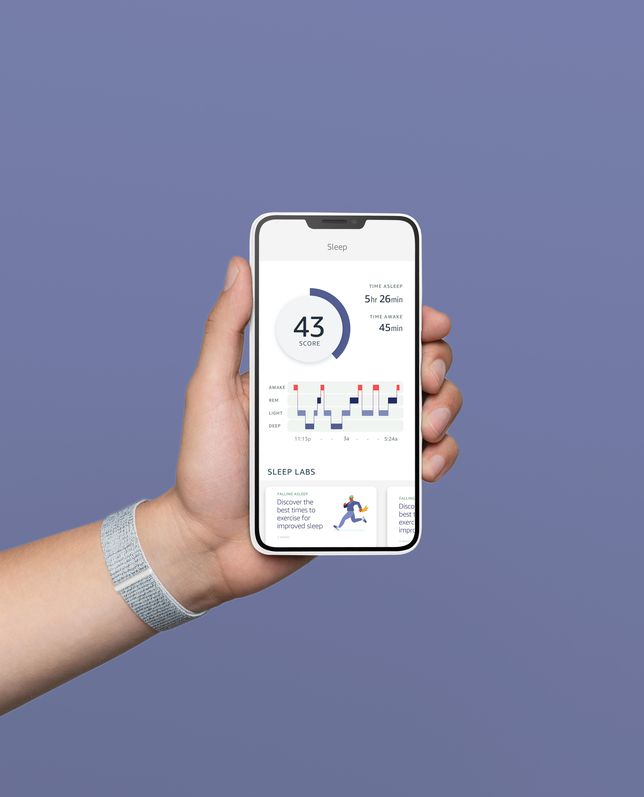
The sleep analysis includes a body temperature to detect variations that may impact sleep.
Amazon
The app provides a comprehensive sleep analysis with a breakdown of the different stages of sleep and overall sleep score, much like other fitness trackers. It also goes beyond the basics by keeping track of your overall body temperature during sleep and creating a baseline for each person. It then charts your average temperature each night relative to your baseline to help you identify variations that could affect your health and the quality of your sleep.
The Halo Band won’t provide a specific body temperature, similar to the way other temperature wearable devices like the Oura Ring already work.
Temperature has become a trending wearable metric in the COVID-19 era: The Oura Ring has one and Fitbit’s newest Sense watch has one too. Amazon’s Halo team is pursuing research for COVID-19 symptom detection on its wearables, much like other health wearable companies, but no specific studies or plans have been laid out yet.
Activity tracking: A week at a glance
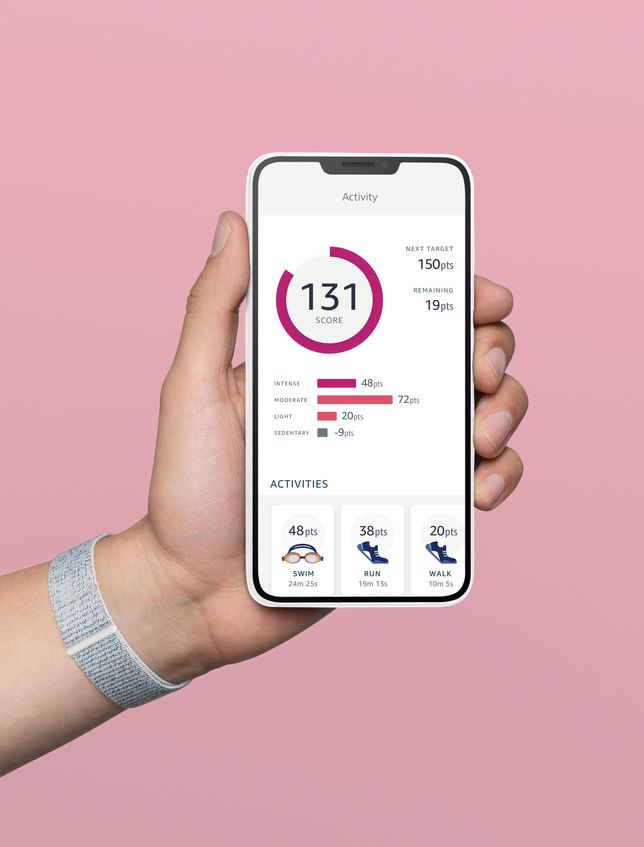
The activity app is based on a weekly point system.
Amazon
Halo also does basic fitness tracking based on the information from the band. It can automatically track walks and runs, but you’ll have to go into the app and tag any other workouts manually.
It rewards you for any type of movement or activity, but gives more points for more intense workouts and subtracts points for sedentary time. And it doesn’t keep a daily tally of your activity, your score is based on the points you accrued during the entire week. The entire picture of exercise, sedentary time and active time is combined into one tally.
Amazon’s sleep and activity scores and other AI tools will require an Amazon Halo subscription; otherwise, the band will default to more basic tracking data. Much like Fitbit and its Premium service, this looks to be continuing a trend of fitness devices that expect a subscription model as part of the package.
A lot of labs and partners, but no Google or Apple integration
A Labs section of Amazon Halo looks similar to what’s on Fitbit’s Premium service, with a lot of multiweek health and fitness goals to opt into, and partners lined up from OrangeTheory to Weight Watchers. Amazon promises these challenges are scientifically vetted, but it also sounds like these challenges will keep being added to over time.
But at least at launch, Halo will not tie in to Apple’s HealthKit or Google’s Fit App which puts it at a disadvantage with people who are already deeply invested in either for health tracking. Amazon is leaning on Weight Watchers, John Hancock Vitality wellness program, and a few others that will be able to hook into Amazon Halo health data.
The looming privacy question
There’s a lot of process in terms of features, and while some seem interesting and innovative, the biggest barrier to entry is privacy. Sharing any kind of health data (let alone unflattering seminudes) requires next-level trust, and you might not be prepared to give Amazon that trust. The company doesn’t exactly have the most pristine track record when it comes to keeping user data private. Alexa-enabled devices have been in the hot seat for storing private conversations “for machine learning purposes.” And Amazon’s Ring doorbell has had a series of privacy dust-ups.
Halo puts privacy in your hands by allowing you to opt out of data sharing with Amazon and third-party apps as well as disable the microphone on the band, but it’s still going to be an uphill battle. That is unless its features prove to be earth-shattering and worth the privacy risk, which remains to be seen.
Amazon is late on arrival
The lack of connection to Apple or Google is telling. Amazon’s making a play in the health and fitness data space, and with Google, Fitbit and Apple already deep in, it’s a big question as to how Amazon will make waves. Or, where Amazon Halo will go next. It’s a platform as much as a wearable, and it sounds like Halo’s early-access experiment may just be the tip of the iceberg.

Amateur music guru. Lifelong coffee scholar. Zombieaholic. Pop culture junkie.
Tech
‘My power is really low’: NASA’s Mars Insight rover prepares to launch from the Red Planet
NASA Lander InSight He has delivered what may be his last message from Mars as he embarks on a historic mission to uncover the secrets of the Red Planet’s interior.
In November, the space agency warned that the probe could be running out of time as dust continued to condense and stifle InSight’s power.
“Spacecraft power generation continues to decline as windblown dust accumulates on solar panels,” NASA said in a statement. Update November 2. “The end is expected to come in the coming weeks.”
message shared NASA The InSight Twitter account tweeted on Monday: “My power is very low so this might be the last photo I can upload. Don’t worry about me: my time here has been productive and uneventful. If I can keep talking to my mission team, I will—but I will.” Subscribe here soon. Thank you for staying with me.”
My power is very low, so this might be the last photo I can upload. But don’t worry about me: my time here has been productive and uneventful. If I can keep talking to my mission team, I will, but I’ll sign here soon. Thank you for staying with me. pic.twitter.com/wkYKww15kQ
— NASA InSight (@NASAInSight) December 19, 2022
A geologist robot armed with a hammer and a seismograph first reached the barren expanse of Elysium Planitia in November 2018.
Since then, she has carried out geological excavations, taking the first measurements of earthquakes with a high-tech seismometer placed right on the surface of Mars.
Last month, the solar-powered car released an update to remind us of its time in space.
“I was lucky to live on two planets. Four years ago I made it safely to the second one, much to the joy of my family at first. Thanks to my team for taking me on this journey of discovery. I hope I can be proud of you.”
According to the published mission, Insight has measured more than 1,300 seismic events since it was published, and more than 50 of them had signals clear enough for the team to extract information about their location on Mars. Results.
The probe’s data also provided detailed information about Mars’ interior, liquid core, surprisingly variable remnants beneath the surface of an extinct magnetic field, climate and seismic activity.
old for Its launch in 2018NASA Chief Scientist Jim Green said the mission was “fundamental to understanding the origins of our solar system and how it became what it is today.”
NASA will not declare the mission complete until Insight confirms the arrival of two spacecraft orbiting Mars that are relaying their information back to Earth.
In 2018, the veteran rover announced the capabilities end of his 15 year stay Sending an incomplete photo of the Valley of Perseverance.
A severe dust storm darkened the sky around the solar-powered rover, shattering the sun and leaving behind a dark image with white spots due to camera noise. The transmission is interrupted before the complete image can be transmitted.

Amateur music guru. Lifelong coffee scholar. Zombieaholic. Pop culture junkie.
Tech
What’s new on February 7, 2023

Being very close companies, OPPO and OnePlus have decided to create a new partnership, with the latter being a pioneer in the market. It has become the representative of the best smartphones in the group, and this will be seen very soon.
Proving this, OnePlus has announced that it will have news soon. The following brand assets will be announced on February 7, 2023. We are talking about OnePlus 11 5G and Buds Pro 2.
In recent years, OnePlus has been showcasing new hardware in an attempt to find a new place in the market. The brand has not always seen its full potential, betting on mid-range or entry-level smartphones.
The situation is changing, and the novelty will go on sale in early 2023, February 7. It is on this day that the new OnePlus 11 5G will be presented with all the expected news. We definitely have the new Qualcomm Snapdragon 8 Gen 2 SoC here. There's still 16GB of storage left and 256GB of onboard storage.
It is expected that he will receive a 6.7-inch OLED display with a resolution of 1440p and a frequency of 120 Hz. In the field of photography, we will have an important change: a 50 MP main camera, a 48 MP ultra wide-angle camera and a 32 MP telephoto lens with 2x zoom. For selfies and video calls, you'll have a 16-megapixel camera.
The photography partnership with Hasselblad will continue with OnePlus for fine-tuning and some additions. This alliance has brought important results for the best smartphones of the brand, guaranteeing the best photos in any situation.
In addition to the new OnePlus 11 5G, another brand new feature is also expected to arrive at the event. We're talking about the Buds Pro 2, which are solidifying an audio commitment that's becoming more of a reality. The brand promises "rich stereo quality sound with crystal clear clarity".
Stays like this marked by the beginning of February, another important novelty will enter the market. OnePlus wants to reclaim its place, and that will be the brand's bet for years to come. OnePlus 11 5G and Buds Pro 2 take the first step in this direction.

Amateur music guru. Lifelong coffee scholar. Zombieaholic. Pop culture junkie.
Tech
New POCO Smartphone Seen in Certification May Debut Soon

According to information provided by Mukul Sharma, the unidentified POCO device can be identified by the model number 22127PC95I. Due to the fact that it was first seen online, the marketing name of this equipment is still a mystery.
POCO has not launched new mobile devices, including smartphones, to the market for some time now. On the other hand, several POCO smartphones such as POKO X5 and X5 Pro have been spotted on various certification sites, suggesting that the company will release these products soon. Today a new smartphone from the sub-brand xiaomi has been spotted on the BIS India website but the device does not have a name or any other details associated with it.
A new POCO device (model number 22127PC95I) has been included in the Indian BIS certification. POCO F5 has the model number 23013PC75I. #A LITTLE pic.twitter.com/NAFloP5Crt
— Mukul Sharma (@stufflistings) December 19, 2022
According to information provided by Mukul Sharma, the unidentified POCO device can be identified by the model number 22127PC95I. Due to the fact that it was first seen online, the marketing name of this equipment is still a mystery. It is possible that it will debut as a mid-range smartphone. The Bureau of Indian Standards (BIS) website, other than the model number of the smartphone, does not provide any additional information about the device. However, this seems to indicate that the product will be available in the Indian market very soon.
In other related news, POCO X5 5G has recently been seen on several certification sites including SIRIM in Malaysia, BIS in India and the US FCC. According to various sources, it is possible that this is a renamed or modified version Redmi Note 12 5Gwhich was recently released in China.
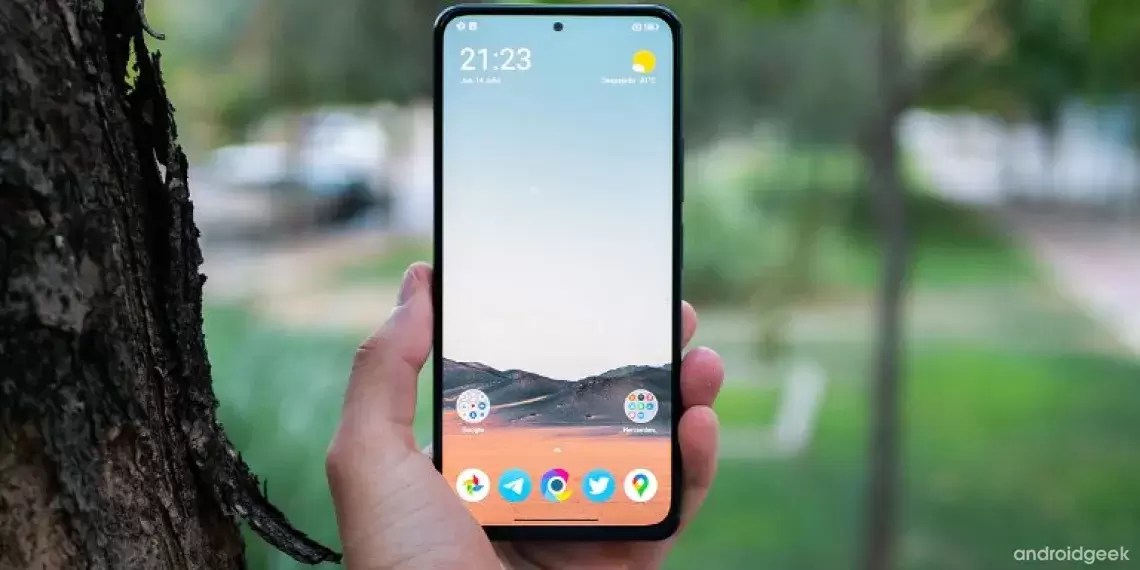
It is supposed to be equipped screen 6.67″ AMOLED display with 120Hz refresh rate and chipset Snapdragon 4 Gen 1 inside. Can run MIUI 13 based on android 12 and have LPDDR4x RAM in addition to UFS 2.2 storage. The front camera is rumored to be 8MP while the main rear camera will be 48MP with 2MP depth. May have the ability drums 5000 mAh and 33W fast charging support.
In addition POCO X5 Pro 5G has recently been seen on various sites dedicated to certification. The battery is said to have a capacity of 5000 mAh and can charge at 67W. It will come with MIUI 14 preinstalled and will support n5, n7, n38, n41, n77 and n78 network bands. 5G.
 Every day we bring you dozens of news from the world of Android in Portuguese. Follow us on Google News. Click here and then on “Subscribe”. Thank you! Every day we bring you dozens of news from the world of Android in Portuguese. Follow us on Google News. Click here and then on “Subscribe”. Thank you! |

Amateur music guru. Lifelong coffee scholar. Zombieaholic. Pop culture junkie.
-
World4 years ago
The Gabby Petito case. Brian Landry set up camp with his family after his girlfriend disappeared
-
Top News5 years ago
Tristan Thompson reacts to Khloé Kardashian’s new appearance
-
Economy2 years ago
Everything has been delivered. 10 Bugatti Centodieci are already in the hands of the owners
-
Top News5 years ago
TLC ‘sMothered’ recap: ‘Party curled up,’ boyfriend problem
-
Top News5 years ago
Alex Cooper hosts a solo podcast
-
Top News5 years ago
2021 Ford Bronco price: Here’s how much the 2-door and 4-door cost
-
Tech5 years ago
Fall Guys is supplying out a legendary costume and Kudos as an apology present
-
Top News5 years ago
Chiara de Blasio was ‘very cold’ during the arrest of the protest: witness













